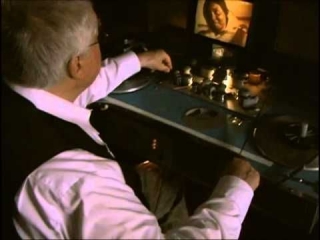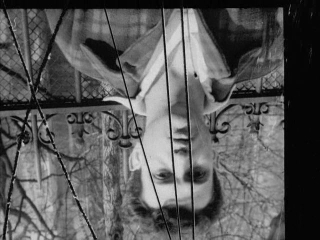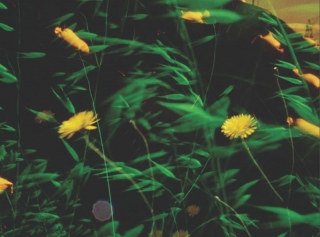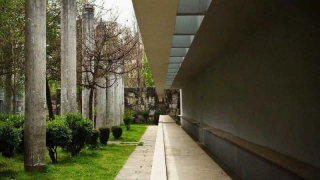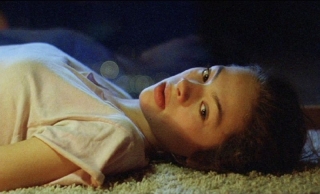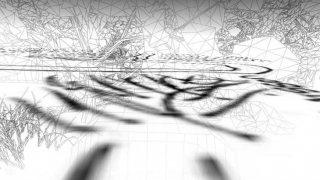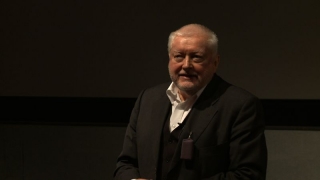Date: 13 October 2012 | Season: London Film Festival 2012 | Tags: London Film Festival, Peter Kubelka
FRAGMENTS OF KUBELKA
Saturday 13 October 2012, at 1pm
London ICA Cinema 1
Martina Kudlácek, Fragments of Kubelka, Austria, 2012, 232 min
In this extended portrait, Peter Kubelka speaks at length about his life, work and interests, drawing on a vast range of knowledge and experience. Active as a filmmaker since the 1950s, Kubelka’s acclaimed cinematic works are only one aspect of his dynamic personality. In his legendary public lectures, he holds forth on a variety of disciplines including film, music, archaeology and cooking. He has also played an important institutional role in establishing the Austrian Film Museum, and as co-founder of Anthology Film Archives, for whom he designed an ideal viewing theatre known as the Invisible Cinema. Martina Kudlácek (known for previous documentaries on Maya Deren and Marie Menken) immersed herself in Kubelka’s world for several years, researching historical footage, recording lectures, and perhaps most importantly, filming him at home surrounded by his eclectic collection of anthropological objects. In these precious sequences, Fragments of Kubelka provides extraordinary insight in conveying his philosophy on life and art.
PROGRAMME NOTES
FRAGMENTS OF KUBELKA
Saturday 13 October 2012, at 1pm
London ICA Cinema 1
FRAGMENTS OF KUBELKA
Martina Kudlácek, Austria, 2012, HD video, colour, sound, 232 min
Fragments of Kubelka is an epic documentary subtly introduces the complex worldview of iconic filmmaker and theoretician Peter Kubelka (born 1934, Vienna). While Kubelka’s radical and pioneering body of films is a highly condensed work of about an hour, focusing on the essence of cinema, his legendary lectures often unfold over many hours. These lectures on ‘what is cinema’ and ‘cooking as an art form’ are frequently illuminated by presentation of archaeological artefacts from Kubelka’s eclectic collection. He considers his ongoing collecting to be an expanded film practice which explores the evolution of humanity. Martina Kudlácek has carefully woven an open-ended portrait which goes beyond the biographical to reveal fresh insights into the phenomenon of film.
The filmmaker Jonas Mekas has written: ‘Kubelka’s cinema is like a piece of crystal, or some other object of nature: It doesn´t look like it was produced by man; one could easily conceive that it was picked up from among the organic treasures of nature.’
Back to top
Date: 19 October 2012 | Season: London Film Festival 2012 | Tags: London Film Festival
ON VENOM AND ETERNITY
Friday 19 October 2012, at 6:30pm
London BFI Southbank NFT 3
Isidore Isou, Traité de bave et d’éternité, France, 1951, 120 min (new print)
The first and only film by the founder of the French Lettrist movement begins with a warning: ‘Dear spectators, you are about to see a discrepant film. No refunds will be given.’ Advocating for the rupture of language and photography, Isou expects the spectator to ‘leave the cinema blind, his ears crushed, both torn asunder by the disjunction of word and image’. At the 1951 Cannes Festival, where Traité received its first pubic screening, it won the admiration of Guy Debord and Jean Cocteau, who wondered if it would take 50 years before its radical aesthetics could be understood. The Lettrists believed the development of cinema had been stalled by the domination of the studio system. In order for a new cinema to emerge, it had first to be destroyed – symbolically and physically – by bleaching and scratching the images, and by replacing soundtracks with abrasive concrete poetry and enraged tirades.
PROGRAMME NOTES
ON VENOM AND ETERNITY
Friday 19 October 2012, at 6:30pm
London BFI Southbank NFT 3
TRAITÉ DE BAVE ET D’ÉTERNITÉ (ON VENOM AND ETERNITY)
Isidore Isou, France, 1951, 35mm, b/w, sound, 120 min
Isidore Isou arrived in Paris from Romania in 1945 where he founded the Letterist movement, an art and literary movement that owed inspiration to Dada and Surrealism. Letterism attempted to break down poetry into letters and syllables, and then all arts into their constituent parts, to build up new languages for each art form. Isou wrote, directed, photographed, composed the music for, and acted in Traité de bave et d’éternité (Treaty On Venom And Eternity), the first Letterist film manifesto. Isou proceeds to discuss what is wrong with the cinema and then counter it with what he thinks the cinema should consist of through ‘Discrepant Cinema’ in which the sound and the picture are purposefully unrelated and the images are manipulated or destroyed through bleaching and scratching.
Isou brought Traité de bave et d’éternité uninvited to the Cannes Film Festival (1951) where it both caused a riot and won the audience prize for the avant-garde. Isou’s ‘revolt against cinema’ is a landmark work that prefigured the Letterist and Situationist cinema to come and influenced many experimental filmmakers, including Stan Brakhage. The film’s participants include some of the greatest names in 20th Century French arts and letters: Jean-Louis Barrault, Blaise Cendrars, Daniel Gélin, Colette Marchand, André Maurois, and Jean Cocteau (who also designed the poster promoting the 1952 release on the Champs-Elysees). (Re:Voir)
In the above context of The Lumières and Méliès as ‘the 2 wings’ of Film, I take Isou to be the visceral backbone, complete with electrically ‘scratched’ nervous system synopting – all rhythms tending to that consciousness we know as cathexis or investment. His Traité has certainly been prime inspiration for all of my film-making, since I first saw it, and for many of the U.S. independent film-makers … and I do not mean simply for (how did you put it?) the ‘scratch or blinking films’. The verbal rethoric of Traité is at one with the aesthetic of the moving picture imagery and in its subtle weave of be-seemingly dull photography (which effectually obliterates traditional and slavishly composed photography – whether scratched-over, turned upside-down or not). Traité opened each sensibility (that will be open to it) for new feeling about film, thus for the new feelings each might have uniquely rising in each self appropo [sic] that which is intrinsically Film. I know no other works of cinema which, without intruding its own aesthetic, more frees human sensibility to dance, in the mind’s eye, with cinematic possibilities. (Letter from Stan Brakhage to Frédérique Devaux)
Back to top
Date: 20 October 2012 | Season: London Film Festival 2012 | Tags: London Film Festival
NATHANIEL DORSKY & JEROME HILER
Saturday 20 October 2012, at 2pm
London BFI Southbank NFT 3
While others bemoan the end of celluloid, Nathaniel Dorsky – whose work has become an annual highlight of the festival over the past decade – continues apace, more productive now than ever. His carefully considered practice has this year created works of great beauty from a period of sorrow. This screening of two new films will be complemented by rarely exhibited work by his companion Jerome Hiler.
Nathaniel Dorsky, August and After, USA, 2012, 19 min
‘After a lifetime, two mutual friends, George Kuchar and Carla Liss, passed away during the same period of time.’ (ND)
Nathaniel Dorsky, April, USA, 2012, 26 min
‘Following a period of trauma and grief, the world around me once again declared itself in the form of one of the loveliest springs I can ever remember in San Francisco. April is intended as a companion piece for August and After, and is partly funded by a gift from Carla Liss.’ (ND)
Jerome Hiler, Words of Mercury, USA, 2011, 25 min
Jerome Hiler, who shares Dorsky’s heightened sense of wonder at the world around him, builds sensuous layers of superimposition at the moment of shooting. A most private filmmaker, whose primary craft is the less transient medium of stained glass, he has until recently only shown his work as camera originals, thus limiting their public visibility. His inclusion in the latest Whitney Biennial prompted this first digital transfer.
PROGRAMME NOTES
NATHANIEL DORSKY & JEROME HILER
Saturday 20 October 2012, at 2pm
London BFI Southbank NFT 3
AUGUST AND AFTER
Nathaniel Dorsky, USA, 2012, 16mm, colour, silent, 19 min
Nathaniel Dorsky’s August and After is dedicated to two recently departed friends, legendary filmmaker George Kuchar and actress Carla Liss. The film shows them vibrantly, resiliently alive shortly before their passing and then sets off in search of soothing beauty, yielding searing images awash in colours both belonging to and transcending our natural world. Well into the twilight years of 16mm filmmaking, Dorsky continues to present textures and hues that are indispensible to the art of cinema. We will be poorer without them. (Andréa Picard)
www.nathanieldorsky.net
APRIL
Nathaniel Dorsky, USA, 2012, 16mm, colour, silent, 26 min
In my filmmaking I came upon the idea that if I began to arrange images in a certain way, it could transform the ego instead of confirming it. In other words, if you put two shots together to create a solid concept – this is happening, characters getting out of a car and walking down the street, or someone sitting at a window looking – you construct a series of images in such a way that you nurture ego, but then disrupt it through the montage. When you cut to the next shot, there might be a reemergence of presence, but it wouldn’t be a daisy chain back to the previous image, so it wouldn’t solidify the ego. There might be a way of using montage to realize the wisdom of what cinema has to offer. Cinema has great, great wisdom, and it’s very seldom used as a wisdom medium. In a sense, you can nurture the heart in a montage, going from one thing to the next in a way that touches the heart’s intelligence. You can use the energy of the cinema to transform the viewer by letting the viewer rediscover themselves at each moment in the present. (Nathaniel Dorsky interviewed by Ari Spool)
www.nathanieldorsky.net
WORDS OF MERCURY
Jerome Hiler, USA, 2011, video, colour, silent, 25 min
At the very end of ‘Love’s Labour Lost’, as the cast is frolicking around, a messenger comes in to announce a death which brings a sudden shift to the very end of the play. One of the most comical characters, now newly sober, ends the play with a quick dismissal of the audience: ‘The words of Mercury are harsh after the songs of Apollo. You that way – we this way.’Words of Mercury is, if nothing else, economical. It was shot on reversal film and its layers of superimpositions were all shot in the camera. Half of the many fades in the film were made by submerging the original film in a black liquid. The film is silent. The shooting ratio is low and there are areas which are unedited since taken from the camera. I generally shoot first and ask questions later, but I’m struck at the influences that I see in Words of Mercury because they reach back to the very first times that I saw great 16mm films in the early Sixties: Marie Menken, Gregory Markopolous, Stan Brakhage and my lifetime companion Nathaniel Dorsky. (Jerome Hiler)
Back to top
Date: 20 October 2012 | Season: London Film Festival 2012 | Tags: London Film Festival
TWO ARCHITECTURE STUDIES
Saturday 20 October 2012, at 4pm
London BFI Southbank NFT 3
Catalina Niculescu, Along the Lines, UK-Romania, 2011, 16 min
On a trip to her native Romania, the artist’s interest in architectural forms prompted a visual investigation into how decorative and structural motifs recur in buildings from the traditional to the modern.
Thom Andersen, Reconversão, Portugal, 2012, 65 min
Invited to film in Portugal on the occasion of the Vila do Conde festival’s 20th anniversary, Thom Andersen chose to document building projects by Eduardo Souto de Moura, whose work combines modernist aesthetics with traces of the architectural history of his sites. Incorporating local materials with contemporary building techniques, his clean concrete lines harmonise with natural elements and traditional stone walls. Influenced in equal measure by Mies van der Rohe and minimal sculptors such as Judd and Morris, Souta de Moura’s achievements include meticulous linear houses, the Porto subway network, and the monumental Braga Stadium, which rises out of the earth beside a mountain of imposing granite. This leisurely film features 17 such projects and culminates in a conversation between the filmmaker and the distinguished architect.
PROGRAMME NOTES
TWO ARCHITECTURE STUDIES
Saturday 20 October 2012, at 4pm
London BFI Southbank NFT 3
ALONG THE LINES
Catalina Niculescu, UK-Romania, 2011, HD video, colour, sound, 16 min
Following up the artist’s recent journey to Romania, Along the Lines initially started as ‘a study into vernacular elements of Romanian modernist architecture’. In the final project (including a series of collages) the premise is present, recognizable, but is not made explicit. The work deliberately strays from the plan of rigorous study and develops into a visual exercise in which the assumed subjectivity of the artist becomes the mode of argument. The interference vernacular/modernist is not stated or articulated directly but built up on a set of formal associations and visual suggestions. The artist’s approach becomes calm and poetic; free from a precise mission the project embraces the accidental, the deviation, it accumulates discordant elements to produce new possibilities though vulnerable and problematic, the pleasure of the argument comes into play, it disperses from concept into the aesthetic. Comprising a set of chapters, Along the Lines retraces the visual journey of the artist to explore architecture through a meticulous focus on details and geometric shapes. Each ‘chapter’ is preceded by a postcard collage: one geometrical figure is cut out of a natural landscape which literally illustrates the connection idealized by modernists between architecture and natural environment, placing in this way the interest for simple forms into the simplicity of nature. Although at the end of the video you find yourself back to the same landscape, the perception changes, the view is the same, yet your experience is different this time. (Anca Rujoiu)
RECONVERSÃO
Thom Andersen, Portugal, 2012, HD video, colour, sound, 65 min
Reconversão portrays 17 buildings and projects by Portuguese architect Eduardo Souto Moura, accompanied usually by his own writings. It is a search for his architecture, without critical commentary. Only the tour guide at Braga Stadium offers generalizations, which fit that work well enough, but it may be the exception not the rule. Souto Moura has the last word: ‘If there is nothing there, I invent a preexistence.’ Technically, Reconversão combines the crudeness of proto-cinema with the hyperrealism of digital cinema, bringing us back to the ideals of Dziga Vertov. Shooting only one or two frames per second and animating the images, in the manner of Muybridge, produces greater resolution, although not necessarily a greater sense of reality, and brings attention to the movements of water and vegetation that generally pass unnoticed. (Thom Andersen)
Back to top
Date: 20 October 2012 | Season: London Film Festival 2012 | Tags: London Film Festival
MATI DIOP
Saturday 20 October 2012, at 7pm
London BFI Southbank NFT 3
Among the younger generation of artists exploring new approaches to narrative, the work of Mati Diop is notable for its sensitive portrayal of characters and intimate style of filming. Diop is also an actress, playing leading roles in Clare Denis’ 35 Shots of Rum and Antonio Campos’ Simon Killer, and is the niece of legendary Senegalese director Djibril Diop Mambéty. Her recent short films will be presented together for the first time in the UK.
Mati Diop, Atlantiques, France-Senegal, 2009, 16 min
‘A story about boys who are continually travelling: between past, present and future, between life and death, history and myth.’ (MD)
Mati Diop, Big in Vietnam, France, 2012, 29 min
When a lead actor disappears from set, the director searches for him in the city of Marseille. Stumbling into a karaoke bar, she loses herself in memories of her former home in Vietnam, and encounters a man who shares her sense of displacement. As night becomes day, they walk along the seafront and he recounts the story of his journey from the Far East to Europe.
Mati Diop, Snow Canon, France, 2011, 33 min
Stranded in her parents’ chalet in the French Alps, a teenage girl passes time chatting online with friends, until the babysitter arrives and events take an unexpected turn. Innocent pastimes give way to games of power and seduction.
PROGRAMME NOTES
MATI DIOP
Saturday 20 October 2012, at 7pm
London BFI Southbank NFT 3
ATLANTIQUES
Mati Diop, France-Senegal, 2009, video, colour, sound, 16 min
Sitting by the campfire, a boy from Dakar named Serigne tells his two friends the story of his sea voyage as a stowaway. Not only he, but everyone in his surroundings seems to be continually obsessed by the idea of trying to cross the sea. His words reverberate like a melancholy poem. A story about boys who are continually travelling: between past, present and future, between life and death, history and myth. (Mati Diop)
BIG IN VIETNAM
Mati Diop, France, 2012, video, colour, sound, 29 min
In the forest near Marseille, the Franco Vietnamese director Henriette Nhung is shooting Dangerous Liaisons with the help of her son Mike. But when the lead actor disappears, everything comes to a halt. The film loses its Valmont, and the director soon after. Behind her, she leaves the entire cast and crew, now passengers aboard a ghost ship with only the young Mike as captain. As she wanders the port city, Henriette discovers a world that reminds her of her former home, Vietnam. Here, she meets a man haunted by a long journey with no return. (Mati Diop)
SNOW CANON
Mati Diop, France, 2011, 35mm, colour, sound, 33 min
The French Alps, February 2011. Vanina likes to hear the chalet’s parquet floor squeaking beneath her bare feet. Vanina likes to coat herself in sunscreen cream in front of the stone fireplace. Vanina likes the tawny fur of her rabbit, Souci. Vanina likes to smell the leather of the white sofa. Vanina likes to spend hours contemplating the sultry glow of the eyes of the veiled women on the postcards in her collection. Vanina likes to chat with Eloïse on the internet. But above all, what Vanina likes is her American babysitter, Mary Jane. (Mati Diop)
Back to top
Date: 20 October 2012 | Season: London Film Festival 2012 | Tags: London Film Festival
RITES OF PASSAGE
Saturday 20 October 2012, at 9pm
London BFI Southbank NFT 3
Steve Reinke, Great Blood Sacrifice, USA, 2010, 4 min
‘Whatever is going on on top, there’s a precise machine at work below, and this machine is digging little grooves, and these grooves slowly join together and become the conduits by which all meaning is drained from the world.’ (SR)
Hayoun Kwon, Manque de preuves, South Korea-France, 2011, 10 min
To cleanse his village of demons, the chief of a Nigerian tribe plans to sacrifice his twin sons. One escapes and flees to Europe, where his application for asylum is dismissed through lack of material proof. Using his testimony as the basis, Kwon proposes an animated depiction of his account.
Gabriel Abrantes, Birds, Portugal-Haiti, 2012, 17 min
Pagan folk myth is juxtaposed with ancient Greek comedy as three Haitian girls witness disparate forms of storytelling. An old man tells the tale of his wife’s transformation into a goat. In a local village, an elaborately costumed theatre group performs Aristophanes’ Birds in the original Attic language.
Ben Russell & Jim Drain, Ponce de León, USA, 2012, 26 min
‘Our Ponce de León is an immortal for whom time poses the greatest dilemma – it is a constant, a given, and his personal battle lies in trying to either arrest time entirely or to make the hands on his clock move ever faster. For Ponce de León, time is a problem of body, and only by escaping his container can he escape time itself.’ (BR)
Ben Russell, River Rites, USA-Suriname, 2011, 12 min
‘Trance dance and water implosion.’ A constantly moving camera passes through a complex choreography of bodies engaged in rituals of work and play along the Upper Suriname River.
PROGRAMME NOTES
RITES OF PASSAGE
Saturday 20 October 2012, at 9pm
London BFI Southbank NFT 3
GREAT BLOOD SACRIFICE
Steve Reinke, USA, 2010, video, colour, sound, 4 min
A walk with shaky hand held camera through the landscape of the high desert of New Mexico, down the cliffs to a water reservoir accompanied by Reinke’s voice over. (Argos Arts)
www.myrectumisnotagrave.com
MANQUE DE PREUVES (LACK OF EVIDENCE)
Hayoun Kwon, South Korea-France, 2011, video, colour, sound, 10 min
In Nigeria, to be a twin can be a blessing or a curse. The father of O is the village chief, a witch doctor who believes in the curse of twins. One day, this witch doctor tried to kill his two sons during a ritual ceremony: O managed to escape but saw his brother being murdered. Having fled across his country, he succeeded, by chance, in leaving Nigeria and going into exile in France. In this context, he applied for asylum but his application was refused because he could not produce any proof. (Hayoun Kwon)
BIRDS
Gabriel Abrantes, Portugal-Haiti, 2012, video, colour, sound, 17 min
Three Haitian girls wander through the ripe vegetation and colonial ruins of tropical Jakmel. After listening to an old man’s perverse folk tales they make their way to the town square and see a local staging of a comic masterpiece from ancient Greece; Aristophanes’ Birds. The film’s mysterious intertwining of disparate cultural forms serves as an ode to the potentials of cultural creolization. (Gabriel Abrantes)
mutualrespectproductions.blogspot.co.uk
PONCE DE LEÓN
Ben Russell & Jim Drain, USA, 2012, video, colour, sound, 26 min
‘I could do wonders if I didn’t have a body. But the body grabs me, it slows me, it enslaves me.’
Our Ponce de León discovered the fountain of youth and drank of immortality in the waning moments of his life. In an instant, he became old forever – an 80-year old Spaniard who would continue to walk the earth for century after century after century, watching as coral foundations gave way to mangrove swamps, as swamps were drained and buildings were erected, as buildings decayed and swamps returned. Our Ponce de León is an immortal for whom time poses the greatest dilemma – it is a constant, a given, and his personal battle lies in trying to either arrest time entirely or to make the hands on his clock move ever faster. For Ponce de León, time is a problem of body, and only by escaping his container can he escape time itself. (Ben Russell)
www.dimeshow.com
RIVER RITES
Ben Russell, USA-Suriname, 2011, video, colour, sound, 12 min
A trance dance and water implosion, a kino-line drawn between secular possession and religious phenomena. Filmed in one shot at a sacred site on the Upper Suriname River, the minor secrets of a Saramaccan animist everyday are revealed as time itself is undone. Rites are the new trypps; embodiment is our eternal everything. (Ben Russell)
www.dimeshow.com
Back to top
Date: 21 October 2012 | Season: London Film Festival 2012 | Tags: London Film Festival, Peter Kubelka
PETER KUBELKA PRESENTS MONUMENT FILM
Sunday 21 October 2012, at 2pm
London BFI Southbank NFT 1
Peter Kubelka, Monument Film, Austria, 2012, c.90 min (lecture screening)
The Austrian filmmaker Peter Kubelka has been a vital and uncompromising force in cinema for more than half a century. In a body of work that lasts not much more than an hour in total, he condenses and articulates the essential qualities of analogue cinema, distinguishing film as an autonomous artform. His 1960 film Arnulf Rainer, composed only of the purest elements of light and darkness, sound and silence, remains one of the most radical achievements in film history. In 2012, his new work Antiphon – in equal terms a response to that earlier film and a testament to the entire medium – will be revealed in a unique lecture screening. With 35mm projectors situated in the auditorium, each film will be screened individually, then combined as double projections, both side-by-side and superimposed upon each other. Throughout the event, Kubelka will explicate his theories, communicating his enthusiasm for cinema, and the differences between film and digital media.
Please Note: The projection of Monument Film was unfortunately cancelled due to technical problems. Peter Kubelka presented a verbal lecture on this occasion, and the complete event was rescheduled for Tuesday 9 April 2013.
PROGRAMME NOTES
PETER KUBELKA PRESENTS MONUMENT FILM
Sunday 21 October 2012, at 2pm
London BFI Southbank NFT 1
I am announcing a new film ANTIPHON (2012) which is part of a new work MONUMENT FILM (2012).
ANTIPHON is constituted by the same four basic elements of cinema
– light and darkness, sound and silence – as my film ARNULF RAINER, but it has the opposite form. Negative becomes positive, positive becomes negative, silence becomes sound, sound becomes silence.
MONUMENT FILM appears in TWO forms:
I
Projection in a dark and silent space:
1) ARNULF RAINER
2) ANTIPHON
3) ARNULF RAINER and ANTIPHON projected at the same time, side by side. The appearance is continuous light alternating in space between two projectors, and continuous sound alternating between two speakers.
4) ARNULF RAINER and ANTIPHON projected at the same time on one screen with one speaker. The appearance theoretically is continuous projection of WHITE light and continuous sound, but there is a slight alternation between the two machines, articulating the materiality of classic cinema.
II
Installation in a bright rectangular space defined by three white walls:
The films are cut, each in 128 equally long strips, which hang on nails and are arranged in a rectangular, metric form.
1) Left wall: ARNULF RAINER
2) Right wall: ANTIPHON exactly opposite
3) Centre wall: ARNULF RAINER and ANTIPHON placed one over the other. The appearance is theoretically a BLACK rectangle but the antiphony is articulated by the two strips of film. (Peter Kubelka)
The Monument Film installation is on display in the BFI Southbank Atrium for the duration of the Festival.
Back to top
Date: 21 October 2012 | Season: London Film Festival 2012 | Tags: London Film Festival
WHERE THE MAGIC HAPPENS
Sunday 21 October 2012, at 7pm
London BFI Southbank NFT 3
Peter Miller, Ten Minutiae, Germany, 2012, 5 min
A series of brief exercises in cinematographic magic.
Shumona Goel & Shai Heredia, I am Micro, India, 2011, 15 min
‘Shot in an abandoned optics factory and centred on the activities of a low budget film crew, I am Micro is an experimental essay about filmmaking, the medium of film, and the spirit of making independent cinema.’ (SG/SH)
Kevin Jerome Everson, Rita Larson’s Boy, USA, 2012, 11 min
In one of a trilogy of works based on personalities from the filmmaker’s parents’ hometown, actors audition for the role of sitcom character Rollo Larson. As they attempt to inhabit the character, subtle variations in delivery bring a hypnotic dimension to disconnected lines and repetitive actions.
Erin Espelie, True-Life Adventure, USA, 2012, 4 min
Espelie trains her camera on the myriad life forms that coexist within a small area around a mountain creek. ‘When nature writes the screenplays, she doesn’t abide by crescendos.’ (EE)
Nick Collins, Dark Garden, UK, 2011, 9 min
Contours of light define the flowers and plants of a winter garden, filmed against the black expanse of the night sky.
Robert Todd, Within, USA, 2012, 9 min
‘A film that sustains a complex condition: keeping the inner world alive as the camera looks ‘out’ upon the world.’ (RT)
David Gatten, By Pain and Rhyme and Arabesques of Foraging, USA, 2012, 8 min
An ‘experiment touching colours’ inspired by 17th Century scientist Robert Boyle, bringing together exquisite images shot over a 13-year period. Its title, from a sonnet by Jorie Graham, encapsulates the process and infers its poetic consequence.
Ben Rivers, The Creation As We Saw It, UK-Vanuatu, 2012, 14 min
Unexpectedly given the opportunity to travel anywhere in the world, Ben Rivers chose Vanuatu in the South Pacific. Amidst the villages and landscapes of this remote archipelago, he sought out the creation myths and folktales of a distant culture.
Erin Espelie will give a talk and screening at The Natural History Museum on Mon 22 Oct 2012, at 2:30pm.
PROGRAMME NOTES
WHERE THE MAGIC HAPPENS
Sunday 21 October 2012, at 7pm
London BFI Southbank NFT 3
TEN MINUTIAE
Peter Miller, Germany, 2012, 16mm, b/w, silent, 5 min
Minutiae are ‘little things’. Here are ten. These little things comprise an exhibition exalting the cinema. (Peter Miller)
www.petermiller.info
I AM MICRO
Shumona Goel & Shai Heredia, India, 2011, 35mm, b/w, sound, 15 min
I Am Micro is an experimental film portrait of an anonymous filmmaker struggling to make films against innumerable odds. A stream of consciousness voiceover describes the film artist as a fragile, amorphous being, working in isolation, within a competitive film industry built by businessmen. The film was shot on black and white 16mm at National Instruments Limited, a now defunct factory in Calcutta which once produced cameras. I Am Micro combines lyrical tracking shots of obsolete machinery and dismembered cameras, with behind the scenes footage of an independent film production in Bombay. (Shumona Goel & Shai Heredia)
RITA LARSON’S BOY
Kevin Jerome Everson, USA, 2012, video, b/w, sound, 11 min
Rita Larson’s Boy portrays ten actors auditioning for the role of Rollo Larson in the 1970s TV sitcom Sanford and Son (the American remake of Steptoe and Son). It is one of three films included in the Tombigbee Chronicles Number Two. The series of films is based on famous people and objects from Columbus, Mississippi, hometown of Everson’s parents (the Tombigbee is the river the runs though the city). The actor Nathaniel Taylor, raised in Columbus, portrayed Rollo Larson – Rita Larson’s boy. (Kevin Everson)
TRUE-LIFE ADVENTURE
Erin Espelie, USA, 2012, video, colour, sound, 4 min
When nature writes the screenplays, she doesn’t abide by crescendos but makes up each adventure as she goes along. A rivulet of time encased in a sliver of space reveals an abundance of life, an expression of persistence, and a vision of a world expanding beyond the limits of human attempts to contain or conclude. (Erin Espelie)
DARK GARDEN
Nick Collins, UK, 2011, 16mm, b/w, silent, 9 min
Dark Garden is a short film that captures the ghostly images of the artist’s garden in wintertime, a silent world of ghostly apparitions. Skeletal and silvery plants and their supports are conjured out of the black of the screen as a series of filmic epiphanies. (Cinecity)
WITHIN
Robert Todd, USA, 2012, 16mm, colour, sound, 9 min
Within is a film that sustains a complex condition: keeping the inner world alive as the camera looks ‘out’ upon the world. The film, edited mainly in-camera, dives into an interior that drifts increasingly internally, seeking a sort of cave-like milieu that dissolves into abstraction (forms seen in the dark, lacking firm definition, confusing both scales and distances), and then employs real-time complications to bring this internally-directed way of feeling space along with us as it moves into the outside world, or is it an imagined outer world? The film is a further complication of the perspectival explorations present in my film Undergrowth: rather than looking either at a figure or what some imaginary figure might be looking ‘at’, Within lives in a state that seems to resist perspectival definition, hovering somewhere between what is ‘out there’ and an internally defined image space that sees along with it. The film exists in a space that is at once shallow and deep, layered and reflective, barely there and yet very much alive. It is twilight. (Robert Todd)
www.roberttoddfilms.com
BY PAIN AND RHYME AND ARABESQUES OF FORAGING
David Gatten, USA, 2012, video, colour, silent, 8 min
Fourteen years of foraging, repeated attempts at rhyming, painful process of pruning. A love letter of sorts to Robert Boyle, FRS of The Invisible College and the Royal Society of London for the Improvement of Natural Knowledge, in a visual embodiment of an obscure poetic form known as an ‘exploded Petrarchan sonnet.’ Lines by Jorie Graham in ‘Of Forced Sightes and Trusty Ferefulness’, after Sir Thomas Wyatt, informed both the impulse for the journey itself and destination I ultimately sought. (David Gatten)
www.davidgattenfilm.com
THE CREATION AS WE SAW IT
Ben Rivers, UK-Vanuatu, 2012, video, b/w, sound, 14 min
Three mythical stories from the island nation of Vanuatu, South Pacific, concerning the origin of humans, why pigs walk on all fours, and why a volcano sits where it does. (Ben Rivers)
www.benrivers.com
Erin Espelie will present a free screening and talk in the Attenborough Auditorium of the Natural History Museum’s Darwin Centre on Monday 22 October 2012, at 2:30pm.
Back to top
Date: 21 October 2012 | Season: London Film Festival 2012 | Tags: London Film Festival
FLY INTO THE MYSTERY
Sunday 21 October 2012, at 9pm
London BFI Southbank NFT 3
Laida Lertxundi, A Lax Riddle Unit, Spain-USA, 2011, 6 min
‘In a Los Angeles interior, moving walls for loss. Practicing a song to a loved one. A film of the feminine structuring body.’ (LL)
Beatrice Gibson, Agatha, UK, 2012, 14 min
Strangers in a strange land. As the narrator recounts a dream by composer Cornelius Cardew, the viewer is transported from the hills of Snowdonia to a mental landscape where sci-fi commingles with sexual fantasy.
Lewis Klahr, Well Then There Now, USA, 2011, 11 min
Loosely interpreting a scenario by John Zorn, Klahr uses subconscious logic to weave strands of suspense from collaged images and fragments of voiceover.
Mary Helena Clark, The Plant, USA, 2012, 8 min
‘A film filled with clues and stray transmissions built on the bad geometry of point-of-view shots.’ (MHC)
Janie Geiser, Arbor, USA, 2012, 7 min
The layered imagery of Geiser’s uncanny animations suggest surreal worlds and spectral presences. ‘I was wide awake, in a dream.’
Beatrice Gibson, The Tiger’s Mind, UK, 2012, 20 min
Again referencing Cardew, Gibson’s new project The Tiger’s Mind takes his 1967 text score and applies it to the process of making a collaborative film, for which each contributor assumes the role of a character. The result is an abstract psychodrama and crime thriller set against the backdrop of a modernist house. Commissioned by The Showroom and CAC Bretigny.
PROGRAMME NOTES
FLY INTO THE MYSTERY
Sunday 21 October 2012, at 9pm
London BFI Southbank NFT 3
A LAX RIDDLE UNIT
Laida Lertxundi, Spain-USA, 2011, 16mm, colour, sound, 6 min
A Lax Riddle Unit shows a series of gentle transformations. Each of the film’s turns reveals a surprise: a woman suddenly appearing in bed, and, from behind an album cover, her shy smile. With the film’s elements of Los Angeles landscape, houseplants, and James Carr’s plaintive ‘Love Attack’, continually rearranged like the letters of the title, which is an anagram for Lertxundi’s own name, there is the sense of kaleidoscopic rotation, breathtaking views made with the slightest of movements: changing light, cuts, and slowly revolving camera pans. (Genevieve Yue)
AGATHA
Beatrice Gibson, UK, 2012, video, colour, sound, 14 min
The side of the frame flares out so you know it’s a dream. It becomes apparent that, although similar, there are profound differences between this planet and our own. The most startling is the lack of verbal language. The narrator, our guide to this world, tells us how communication happens, based on interactions with Gladys and Agatha, two beings that confound as they draw the observer in. The names are created for our benefit, and one must wonder if any observations can be trusted, are they all too written, too read from dialogue that isn’t there? What may be certain is the loosening that happens with regard to interpretation. If words cease to have importance then how can the experiences on this planet be readily expressed? Instead of syntax and meaning we are left with rhythm and colour. Based on a dream had by the radical British composer Cornelius Cardew. (Images Festival)
www.dliub.org
WELL THEN THERE NOW
Lewis Klahr, USA, 2011, video, colour, sound, 11 min
An unfaithful interpretation of John Zorn’s early 80’s film script ‘A Treatment For A Film in 15 Scenes’. I consider Well Then There Now a ‘list’ film since Zorn’s text is really a shot list. An exploration of the singularity of the image but, a playful one. Script and Music by John Zorn; Additional Text Lifts from Philippe Soupalt and Alain Robbe Grillet; Voiceover by Slater Klahr.
(Lewis Klahr)
THE PLANT
Mary Helena Clark, USA, 2012, video, colour, sound, 8 min
A film filled with clues and stray transmissions built on the bad geometry of point-of-view shots. (Mary Helena Clark)
ARBOR
Janie Geiser, USA, 2012, video, b/w, sound, 7 min
From a set of photographs found in a thrift store, Geiser creates a liminal space between representation and abstraction, figure and landscape, fiction and memory. Arbor suggests the fragility and ephemerality of memory and its artifacts through subtle manipulations of the photographs: reframings, layerings, inversions, and through the introduction of three dimensional elements, including flowers and thread. The photographs’ subjects are elusive; they rarely engage the camera; they are glimpsed, rather than seen. They look elsewhere, and wait for something inevitable. Gathering on a hillside, lounging on the grass beyond now-lost trees, the inhabitants of Arbor cycle through their one remembered afternoon, gradually succumbing to time or dissolving into landscape, reserving for themselves what we can’t know – and becoming shadows in their own stories. (Janie Geiser)
www.janiegeiser.com
THE TIGER’S MIND
Beatrice Gibson, UK, 2012, video, colour, sound, 22 min
The Tiger’s Mind is an abstract crime thriller set against the backdrop of a brutalist villa. Six characters, The Tiger, The Mind, The Tree, Wind, The Circle and a girl called Amy (the set, the music, the sounds, the special effects, the narrator and the author respectively) battle one another for control of the film as it unfolds on screen. The film explores the relationships between these characters as they emerge and unfold: grappling, wrestling, and dreaming with one another. The Tiger’s Mind is based on an experimental narrative score of the same name, written in 1967 by the radical British composer Cornelius Cardew. Departing from the character-based and improvisatory nature of the score and working with a fixed group of artists for over a year-long period (Alex Waterman as the Tree, Jesse Ash as the Wind, John Tilbury as the Mind, Celine Condorelli as the Tiger, Will Holder as Amy and Beatrice Gibson as the Circle) the film deployed the score as a production structure inviting the participants to develop its varying components: soundtrack, set, special effects, music and text. The resulting piece presents a portrait of its own making in fictional form, extending narrative and character to the production process itself. Tiger’s sets, Mind’s music, Wind’s effects, Tree’s foley, Amy’s narration and Circle’s authorship all knock up against each other in a battle for primacy. (Beatrice Gibson)
www.dliub.org
Laida Lertxundi will screen her work alongside films by Morgan Fisher, Hollis Frampton
and Bruce Baillie at the ICA Artists’ Film Club on Tuesday 23 October 2012, at 7pm.
Back to top
